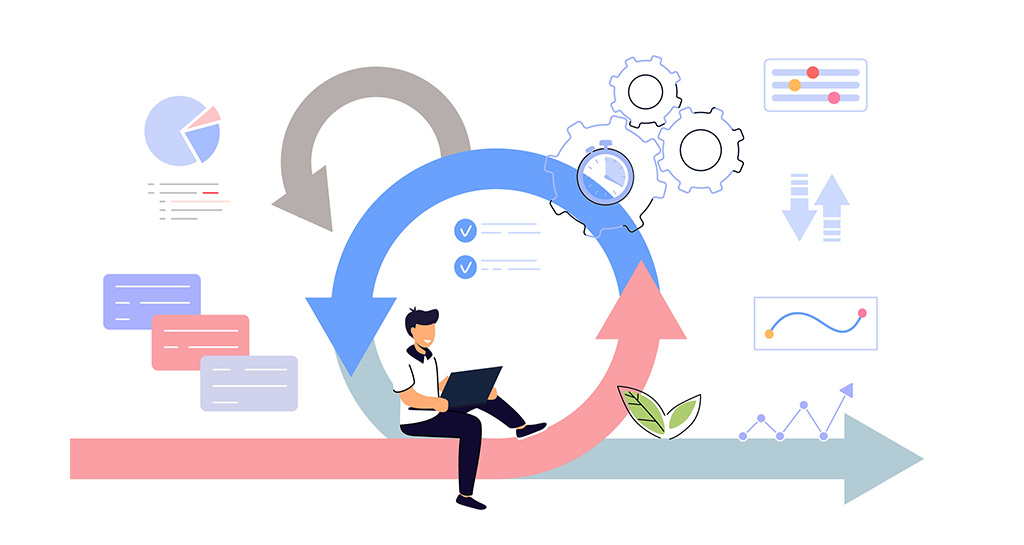
In today’s world, the economic outlook isn’t necessarily optimistic. On the other hand, it’s not entirely pessimistic either. Regardless of what happens with the economy, one thing is clear. Due in part to advancing technologies, we’re seeing change at a faster pace than ever before.
In terms of MarTech projects, teams previously had at least 6-12 months to see results, get feedback, and react accordingly. In the face of today’s economic uncertainty, more and more companies can’t afford that same luxury of time. In fact, leadership and C-suites often require results in a much shorter window so they can validate proof of concept (POC) and ROI.
“This is the way we’ve always done things” probably shouldn’t have a place in any business that wants to thrive for years to come. Your MarTech projects are no exception. To that end, achieving faster results means taking a different approach.
The solution may surprise you. While Agile methodology may not seem as common in the MarTech space in some organizations, adopting an Agile mindset — particularly regarding analysis and decision-making — is one of the best ways to help your team and company adapt to a rapidly changing business landscape.
What type of MarTech projects are a good fit for Agile delivery?
Before answering that, I need to explain what I mean when talking about Agile, particularly in how it differs from traditional project management and delivery. In software development, traditional waterfall delivery follows a highly-structured linear timeline and focuses on completing projects one stage at a time. However, an Agile approach is inherently flexible and allows teams to prioritize different tasks to get results and feedback much more quickly.
In truth, because there are very few rules about how a project “must be” structured, Agile is more of a mindset than anything. Moreover, it allows for a great deal of experimentation so that teams can test different hypotheses and approaches and rapidly adapt to changing business requirements. There are many agile approaches and techniques in the real world. Scrum and Kanban are among the most popular, widely-used options. When it comes to assessing where and when to employ agile approaches, well-known frameworks like Cynefin can help categorize problem-solving processes for almost any business use case.
The Model for Sustainability of Agile Approach evaluates organizational and project attributes in three major categories – culture, team and project. For more information, I recommend referring to Agile Practice Guide, published by Project Management Institute (PMI) in 2017.
So what does all this have to do with MarTech projects?
Because MarTech projects have so many moving parts, applying an Agile approach is ideal when the stakeholder demands rapid delivery and iteration of products.
By running the agile ceremonies, which include a daily standup meeting, sprint planning and sprint review (and more), the team can quickly reallocate resources and tasks to solve specific problems as they arise, rather than getting too far down any path and redoing work. By streamlining problem-solving in this manner, teams can quickly adapt their approach as necessary.
Additionally, Agile teams typically focus on smaller deliverables that meet sprint goals so they can gather and analyze data, evaluate each iteration and enact a plan for next steps.
What do Agile methodology and scrum delivery look like for real-world MarTech projects?
One of the hallmarks of Agile methodology is its focus on delivering incremental value to the stakeholders in each sprint cycle. By continually creating feedback loops, it’s possible to identify gaps or opportunities and take swift action to better work toward your overall goals.
Wondering what this could look like? Here are some sample practices:
Step 1: Build the product backlog and refine it throughout the sprint planning process.
Step 2: Create user stories, or short explanations of the problem users may seek to solve using their words. By using your customers’ words, your team is more likely to keep their point of view in mind as they create and deliver the solution.
Step 3: After selecting the stories your team needs to finish during a sprint, identify the moving parts and assign team members.
Step 4: Meet daily to review progress, discuss challenges or blockers, and adjust the actions.
Step 5: Reflect on what worked well and what did not during Sprint Retrospective; continue to improve in the next Sprint.
Some projects this could work well for include migrating Marketing Automation Platform (MAP) data or adopting a new MarTech platform. Agile can also be effective in adapting current processes to become more efficient. Then again, it can also be used for developing specific funnels or marketing campaigns, building out what is necessary at each phase.
How does Agile in MarTech work differently for in-house and agency-led projects?
Because of my background in brand management and digital marketing, I’ve worked extensively with in-house teams and marketing agencies on various projects. Ultimately, both types of projects have a lot in common and require strong communication and team collaboration.
Whether you’re managing an internal agile project team or an external team on the agency’s side, setting expectations upfront is critical.
Understand how the stories in each sprint contribute to the final product or service. The client may still possess a waterfall mentality especially if they are new to Agile methodology. If the client is at all anxious about whether the project is headed in the right direction, they may request frequent status updates in the middle of a sprint. When you respond to the request in a timely manner. It’s actually a great opportunity to increase transparency and build stronger trust. What’s more, you can maximize time in these client sprint review meetings by using them to gather feedback and close feedback loops quickly.
Because Agile is so flexible, there’s no one-size-fits-all way to bring it into your MarTech projects. You can follow Agile methodology to a tee or take a hybrid approach. Daily meetings may not be necessary for some teams, instead shifting to every few days or even once a week based on project goals.
Who is in charge of what in an Agile-driven MarTech project?
Even though an agile/scrum team typically consists of a product owner, development team and scrum master, having a project manager (PM) and product owner (PO) at the same time can also work out well.
Usually, the PM oversees the mile-high view of the project, maintaining comprehensive insights into skill, budget, time, goals and compliance, among other aspects of the project. Conversely, the PO focuses on managing sprints, interfacing with the development team, backlog management, sprint planning meetings, collecting feedback and working with the PM on change management. To some degree, the PM functions as a Scrum Master if they are familiar with Agile or have been certified.
Benefits of using Agile and scrum delivery in MarTech projects
Truthfully, the benefits are endless, particularly in a world of constant change. Companies that can swiftly adapt to changing marketplace conditions are more likely to position themselves to thrive in the coming months and years.
By constantly embracing and adapting to changes, it’s possible to close the feedback loop faster with stakeholders and deliver those results faster than the traditional 6-12 month period.
Ready to implement Agile in your MarTech project?
Our team can help you implement Agile for your MarTech projects with a step-by-step change implementation that makes it easier to form a robust Agile project team. Contact us today to learn how.

Grace Chen is a Project Manager and certified Project Management Professional (PMP) with BDO Digital’s Demand Generation Group. She received her Master of Business Administration with a focus on Services Marketing from Arizona State University. With 10 years of rich experience in digital marketing strategy, MarTech, and project delivery in the consumer goods, manufacturing, software, and professional services sectors, Grace has worked closely with top creative agencies to help some of the most recognizable global brands deliver high-performance integrated marketing projects.
The post How to Maximize the Value of Agile Methodology in MarTech Project Delivery appeared first on DemandGen.





















